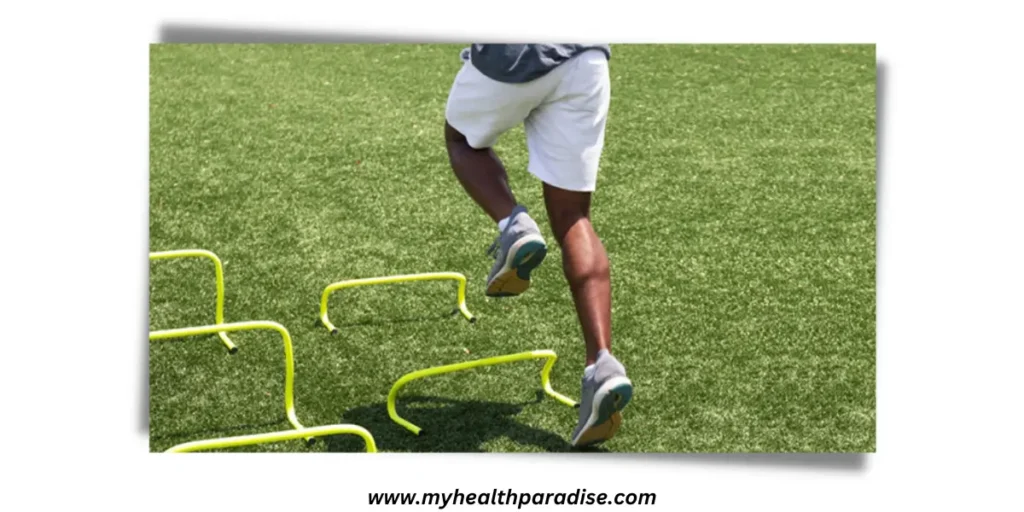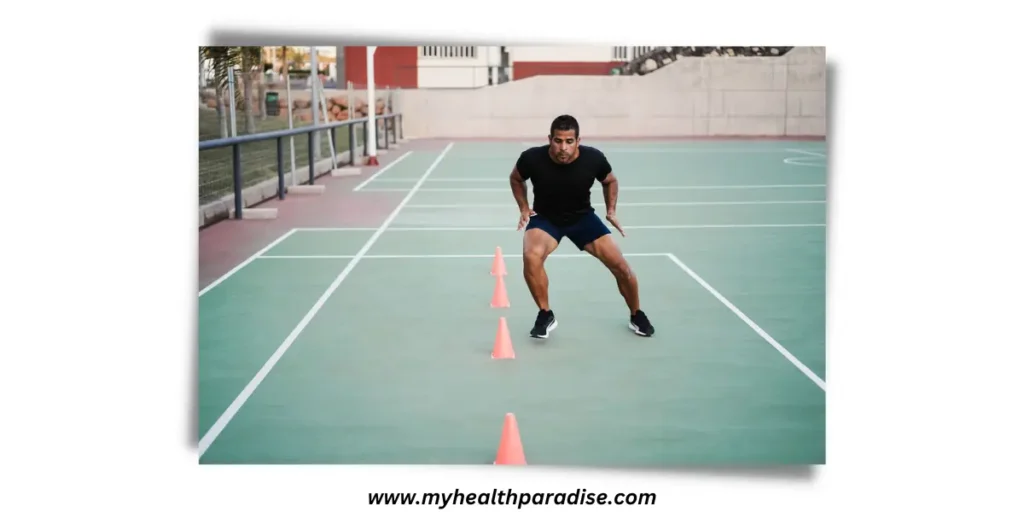Athletic performance is a multifaceted construct, wherein agility holds a paramount position due to its pivotal role in facilitating swift and efficient responses to varying stimuli and changes in direction.
Our guide delves into a comprehensive analysis of the myriad exercises geared towards improving not only speed and coordination but also overall athletic proficiency.
What is Agility Training?
The concept of agility training pertains to a specific genre of physical training aimed at enhancing an individual’s capacity to navigate varying stimuli, alter their trajectory and direction promptly and proficiently, and move rapidly with optimal efficiency.
By adhering to training exercises, athletes can augment their speed, coordination, and efficacy, ultimately improving their overall physical performance.
Why is Agility Important for Athletes?
The significance of agility in athletic performance is monumental as it empowers athletes to traverse swiftly and skillfully in response to diverse stimuli, thus elevating their overall athletic capability and mitigating their vulnerability to injuries.
READ ALSO >>HEART HEALTH MADE EASY: PREVENTION TIPS TO AVOID HEART DISEASE
Key Components of Effective Agility Training
Regulating and boosting agility necessitates an effective training exercises program comprising several essential components.
Speed and coordination drills, footwork drills, reaction time drills, and balance and stability exercises are among the most vital aspects of an effective training exercise program.
These indispensable components work in tandem to improve an individual’s overall agility and physical proficiency.
Speed and coordination drills
- Footwork drills
- Reaction time drills
- Balance and stability exercises
Effective Agility Training Exercises
There are many different agility training exercises that you can use to improve your speed and coordination. Some of the most effective exercises include:

1. Ladder Drills
Ladder drills remain a quintessential agility training exercise renowned for their potential to bolster foot speed and coordination. To execute ladder drills, you’ll require a ladder and some cones.
To initiate the process, align the cones in a linear formation, with the ladder positioned in the center. Afterward, adroitly and promptly shift your feet in and out of each ladder rung, maintaining bent knees and keeping your feet in close proximity to each other.

2. Hurdle Drills
Hurdle drills remain another timeless training exercises that can considerably elevate your foot speed and coordination. To perform hurdle drills, you’ll need a few hurdles and cones.
Start by erecting cones in a straight line with hurdles placed intermittently between each cone. Thereafter, run through the cones, jumping over each hurdle with finesse and agility.

3. Shuttle Runs
Shuttle runs are a remarkable training exercise that can substantially enhance your speed and reaction time. To perform shuttle runs, you’ll need a starting line and two cones, strategically placed at either end.
Start by standing at the starting line, with your eyes fixed on the cones’ locations. Run to one cone, touch it with your hand and quickly turn around to run back to the starting line.
Repeat this process to touch the second cone before immediately running back to the starting line. Perform the shuttle runs multiple times, making sure to change direction with precision and celerity.

Benefits of Agility Training
There are many benefits to incorporating agility training into your fitness routine, including:
- Improved speed and coordination
- Reduced risk of injury
- Increased athletic performance
- Improved reaction time
Incorporating Agility Training into Your Fitness Routine
Integrating training exercises into your workout routine can aid in achieving the above-mentioned gains and attaining your fitness objectives.
When incorporating agility training, it is crucial to concentrate on a range of diverse exercises, such as coordination drills that increase speed, footwork drills that improve your footwork, reaction time drills that enhance your response time, and balance and stability exercises that augment stability.
Final Thoughts
That’s a great summary of the importance of agility training and the benefits it can provide for athletic performance.
By incorporating a variety of agility exercises into a fitness routine, individuals can improve their physical abilities and reduce their risk of injury.
Overall, agility training is a great way to enhance athletic performance and achieve fitness goals.
FAQs
Agility training pertains to a type of physical training regimen that emphasizes the enhancement of an individual’s capacity to swiftly and effectively react to a wide range of stimuli, adapt their trajectory and orientation, and move with utmost alacrity and efficiency.
The attribute of agility holds a pivotal role for athletes, for it empowers them to nimbly and adroitly maneuver in reaction to an array of stimuli, thereby heightening their athletic prowess and decreasing their susceptibility to injuries.
To execute effective agility training, several crucial components must be incorporated, such as drills targeting speed and coordination, footwork, reaction time, and exercises aimed at bolstering balance and stability.
Incorporating ladder drills, hurdle drills, and shuttle runs into one’s agility training regimen can prove to be highly efficacious, as these exercises can substantially enhance an individual’s speed, coordination, and overall physical aptitude.
Integrating agility training into one’s physical fitness routine can yield a diverse range of benefits, including betterment in speed and coordination, mitigation of the risk of injuries, the elevation of athletic performance, and enhancement of reaction time.

- Heart Health Made Easy: Prevention Tips to Avoid Heart disease
- Effects of Type 2 Diabetes: What You Need to Know in 2023
- Winter Wellness for Seniors: How to Prevent Vitamin D Deficiency
- Muscle Strength And Balance In The Shoulder Blades
- Mental Health: Simple Strategies for Improving Mental Health
- Breaking the Stigma: How to Cope with Mental Health Challenges

The My Health Paradise team consists of highly experienced and credentialed health and fitness experts dedicated to helping individuals achieve optimal wellness. Our team is based in the USA and has advanced degrees and certifications from top institutions such as the American Council on Exercise (ACE), National Academy of Sports Medicine (NASM), and the International Sports Sciences Association (ISSA) in personal training, nutrition, physical therapy, and sports medicine.
